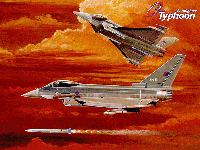

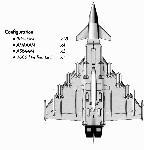
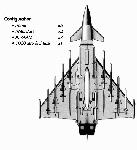
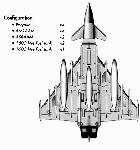
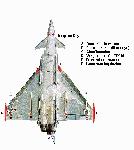
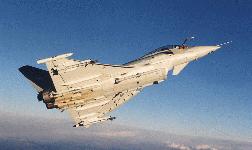


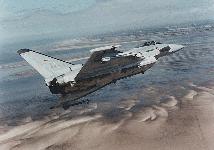
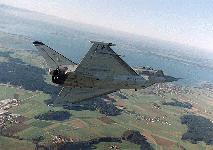
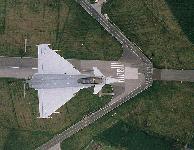
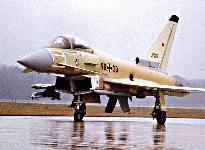
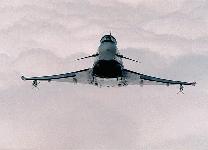
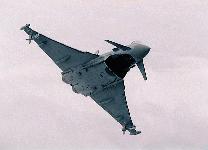
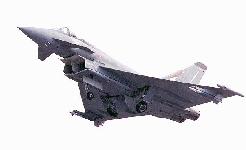
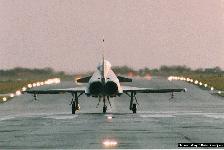
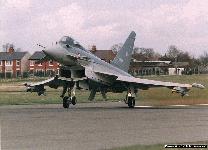
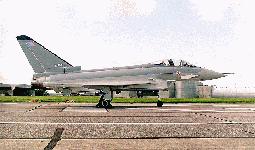
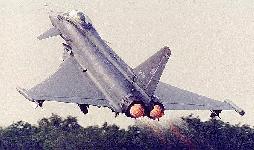
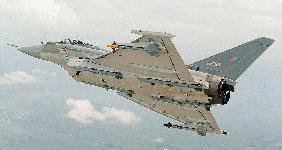




Eurofighter is a single-seat, twin-engine, agile combat aircraft which will be used in the air-to-air, air-to-ground and tactical reconnaissance roles. The design of Eurofighter Typhoon is optimised for air dominance performance with high instantaneous and sustained turn rates, and specific excess power. Special emphasis has been placed on low wing loading, high thrust to weight ratio, excellent all round vision and carefree handling.
Stealth technology is incorporated throughout the aircraft�s basic design. Over seventy percent of the airframe surface area is composed of Carbon Fiber Composites, giving the aircraft an inherently low radar signature. The radar cross section is, however, larger than that of the F-22 and the Joint Strike Fighter. The Eurofighter will rely on enhanced air-to-air missiles that allow the pilot to engage enemy aircraft far outside the range in which the enemy could effectively retaliate.
Eurofighter's air dominance supremacy and versatility as a multi-role combat aircraft is marked by its highly potent and comprehensive air-to-surface attack potential:
Eurofighter�s high performance is matched by excellent all round vision and by sophisticated attack, identification and defence systems which include the ECR 90 long range radar and Infra Red Search and Track (IRST) system, advanced medium and short range air-to-air missiles and a comprehensive electronic warfare suite to enhance weapon system effectiveness and survivability. Eurofighter Typhoon is intentionally aerodynamically unstable to provide extremely high levels of agility, reduced drag and enhanced lift. The unstable design cannot be flown by conventional means and the pilot controls the aircraft via a computerised �fly by wire� system.
The Eurojet EJ200 military turbofan was designed specifically to match Eurofighter Typhoon�s mission requirements. The overall design ensures a small lightweight engine with the thrust and strength to match the typically on demand reheat temperatures generated during combat. The EJ200 engine combines high thrust with low fuel consumption. To reduce ownership cost over Eurofighter Typhoon�s in-service life of 25 years or 6,000 flying hours, and to ensure maximum availability, the important areas of Reliability, Maintainability and Testability have been given equal priority to performance and flight safety.
The UK intends to procure 232 aircraft to replace the Tornado F3 and the Jaguar. Deliveries to the Royal Air Force are scheduled to begin in December 2002 and run until the year 2014. The current estimated total procurement cost of the programme to the UK is �15.9Bn.
The Eurofighter program began formally in 1983 when five European nations (France, Germany, Italy, Spain, and UK) initiated feasibility studies, but France later dropped out to pursue development of the Rafale. The remaining nations agreed to continue the program through a product definition phase. Development of the Eurofighter began in 1987 when European air staff completed the requirement for the then-European Fighter Aircraft. Intended to counter the threat posed by Soviet aircraft then under development, European air forces intended to bring the Eurofighter online by the mid-1990's.
Production contract for the first batch of 148 aircraft were placed by the Eurofighter management agency NETMA (NATO Eurofighter 2000 and Tornado Management Agency) on behalf of the partner nations. Fixed prices were agreed prior to the commitment of each contract. The contracts were signed by NETMA, Eurofighter GmbH and Eurojet GmbH.
Delays, technical difficulties, and political crises derailed the original timeline. The first developmental aircraft did not fly until March 1994 while the first production aircraft did not fly until April 2002.
Since Eurofighter first flew in Germany on 27 March 1994 all seven development aircraft have flown. Aircraft in the flight test programme have completed over 790 sorties (658 hours). Full carefree handling and a speed of Mach 2.0 have been achieved as have air to air refuelling and weapons firings of Sidewinder and AMRAAM. Pilots have described the aircraft as 'exhilarating' to fly.
In September 1998 the Eurofighter was also designated the Typhoon, though this nomenclature is intended only for use in export markets outside Europe. Eurofighter remains the offical name in Europe, and Typhoon will not automatically be the EF2000s name with the four partner air forces when it enters service in 2002/3.
British Eurofighter aircraft are assembled at British Aerospace sites in Lancashire from components manufactured by companies in the four partner nations. Rolls Royce will manufacture the engines, mainly in Bristol and Derby. In the other nations the respective partner companies will have their own assembly lines in Munich, Turin and Madrid. Some 200 UK companies, including GEC Marconi, Dowty, Lucas, Martin Baker, Normalair Garrett, Pilkington Thorn Optics, Smiths Industries, Computing Devices and Ultra Electronics, are involved in the development of a range of equipments for Eurofighter, including the radar and defensive aids subsystem. In the UK, over 6000 jobs depend on the Eurofighter development phase and this is expected to rise to some 14000 at the peak of production.
Eurofighter production will make use of several innovations in production engineering. These include the use of a modern integrated design, manufacturing and management systems and the introduction of automated processes for the production of a number of aircraft components.
Despite the announcement in early 2002 that delivery of the first set of production aircraft would be postponed until December 2002, the Eurofighter testing and evaluation programs posted several important firsts during the first months of 2002. The first Instrumented Production Aircraft (IPA) flew their initial flights in April 2002. Also in April, developmental aircraft demonstrated the first guided-launch of an AIM-120 AMRAAM, scoring a direct hit to destroy the target drone, while testing the Eurofighter's in-flight refueling capability.
Under the revised schedule, the first batch of 55 production aircraft will be delivered to the partner countries in Dec. 2002 to facilitate training and conversion. Follow-on aircraft will be delivered through 2005. Initial Operational Capability is expected by Jan. 2006, though Defense Ministers in the partner nations remain vague about the precise date.
Delivery of the Eurofighter will likely comprise one production run of approxiamtely 148 aircraft (Tranche 1)and two production runs of approxiamately 236 aircraft (Tranches 2 and 3). As of June 2002, only Tranche 1 aircraft are firmly contracted under fixed-price agreements. Tranche 1 aircraft focus on the Eurofighter's original, primary role of air defense, but aircraft in Tranches 2 and 3 will incorporate and integrate maturing technologies to embrace the Eurofigher's multi-role mission.
The first Tranche 1 aircraft will be cleared for training roles only, pending software updates that will clear the aircraft for air-to-air and limited air-to-surface operations. Tranche 1 aircraft, optimized for an air defense role, will mount AMRAAM, ASRAAM, and AIM-9L air-to-air missiles, with potential integration of the Paveway II (UK) and the GBU-16 (Italy).
Under current plans, Tranche 2 aircraft will be delivered 2006-2010, although no price agreements have been negotiated to date. Enhanced operational capabilities proposed for Tranche 2 aircraft include integration of precision ground-attack weapons, the Brimstone anti-armor missile, and the Storm Shadow and KEPD 350 Taurus land-attack cruise missiles. Integrating the IRIS-T imaging-infrared short-range weapon, the AIM-120C-5 AMRAAM, and, later, the Meteor air-to-air missiles will enhance the Eurofighters air defense capability. Other planned enhancements include the addition of laser-designator pods and specialized recconaissance equipment. Tranche 2 aircraft may incorporate a new hardware standard.
To be delivered sometime between 2010 and 2020, Tranche 3 aircraft will incorporate new technologies not yet fully matured. No fixed plans exist to date, but Tranche 3 enhancements will likely support expanded missions, e.g. Extended Air Defense, Suppression of Enemy Air Defense, and Recconaissance, as well as replacing aging avionics and radar components, like the ECR-90 conventional planar array pulse-Doppler radar. Tranche 3 capabilities will be ironed out as each nation's Air Force defines the capabilities that they need to enhance and expand.
Specifications | |
| Wing Span | 10.95m |
| Length | 14.96m |
| Height | 5.28m |
| Wing Area | 50m� |
| Foreplane Area | 2.4m� |
| Empty Weight | 9750 kg (approx) |
| Internal Fuel Load | 4000 kg (approx) |
| External Store Load | 6500 kg (approx) |
| Max T/O Weight | 21000 kg |
| Power | |
| Maximum Speed | 2125 km/hr |
| Time to 10670m | 2.5 minutes |
| Runway Requirement | 700m |
| T/O run | |
| Combat Radius | |
| G Limits | +9/-3 w/ int fuel and two AIM-120 |
| Weapons & Stores |
|




















